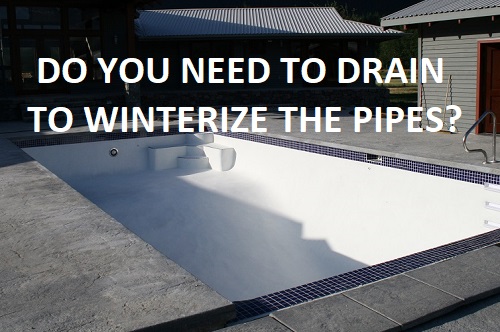Water Level For Winterizing Pool Pipes
SwimmingPoolSteve.com is user-supported. In order to keep this resource about pools and spas available for free to all readers I earn commissions for purchases made through links on this page. For more information see the full disclaimer page. By using this website you are agreeing to the terms and conditions.

When it comes time to winterize your swimming pool a lot of pool owners taking this task on for themselves wonder what water level do you need in the pool to do this. Are you supposed to leave the pool full of water or do you drain below the skimmer mouth? What about the return ports? Do you need to drain the pool below the return ports in order to winterize the plumbing system properly? For my pools I definitely prefer to drain the water below the return ports to facilitate blowing all of the water out before sealing them with plugs for the winter. In this case there really can be no freeze damage to the pipes because there is simply no water left in them at all. No point in adding antifreeze to empty pool pipes so you simply drain the pool, blow out the lines and plug them. I do recommend one additional step which is to put about a foot of backer rod (closed cell foam rope) into the return port before plugging. If the plug leaks and the pipe fills with water the backer rod might just be enough to prevent the return fitting or pipe from splitting when the water freezes.
Now it is definitely worth noting that this is a big, wide world and your pool may be different than my pool. I live and work mostly in Ontario Canada where we can have sustained temperatures below negative thirty degrees (at that point does it matter if it is Celsius or Fahrenheit?) so the freezing conditions that we experience could be described as "extreme". Unless the Iditarod runs through the back half of your property, the chances are that your winter temperatures are no worse than what we experience here in Ontario. But what if you have a unique consideration in that you simply can not drain your pool? There are actually quite a few situation in which you really can not drain your pool, and even more where you can drain a little to get below the skimmer but the return ports are just too low. It might be too much water, or your liner floats when you drain that much, or you have a fiberglass pool and risk floating / cracking the pool to drain that far. So how do these people winterize their returns for the year?

Duck plugs for winterizing pool returns
There are new generation pool winterizing plugs that you can buy that make the process of winterizing your returns a lot easier. Duck plugs are designed to be one way only so you can install them and then blow out the water within the pool system. As soon as you stop blowing the plugs seal with a rubber flapper and does not allow water back in. This is a wonderfully simple solution to such a headache of a problem. While I may not have the confidence with a duck plug that I would with a threaded plug installed with thread sealant, I can not say that I have heard of many cases of these plugs failing and allowing water back into the system. I tend to think these are the best solution for pools that can not be drained below the return lines for whatever reason.
It is worth noting that blowing out your return pipes is actually slightly tricky in that you can trap water inside. Normally you have to work the water out from closest return to furthest return, and to do this with duck plugs means you would have to lay on the deck and manually squeeze the one closest to the pump while you work the water further down the line to the next return. You would get absolutely soaked doing this but if I had a pool with low returns and I could not drain this is exactly the process that I would use.
Blowing out return pipes underwater - When I was young in the pool industry we did not have fancy one way valve duck plugs. All we had were normal threaded winterizing plugs and the willingness to get soaking wet for the cause. When faced with a pool that can not be drained it is at least theoretically possible to reach down and plug the returns while they are underwater. I think a rubber plug set to almost the right size is a good method as you can reach down and jam it in place while the blower is still running. As long as there is another return port open in the line you can manage to do get the plug into the return port. On the very last return the pressure from the blower will be too great and you will have to time having someone turn off the blower as you jam the plug into the return. If you fumble the last plug you really need to pull the other plugs and start again to avoid the potential of trapping water in the system. This is certainly not an ideal way to winterize your returns, and I am not endorsing that you do this. I am simply explaining how we would deal with low set returns on pools that can not be drained before there were better options like duck plugs available.
Do you need antifreeze in pool returns? - If you evacuate the water completely from the plumbing lines of the pool then you, at least in theory, do not directly benefit from the use of antifreeze other than a layer of backup protection. So in the vast majority of professionally winterized swimming pools no antifreeze products are used on the return pipes. Most commonly antifreeze is used in the skimmer pipes, the skimmer body, and the body of automatic water fill units adjacent to the pool. It does not hurt if you want to go the extra mile to add pool antifreeze but then you will be adding this directly to your pool in the spring when you open up the pipes.
Most pools can handle being drained below the skimmer faceplate as this is only about three inches lower than the ideal operating level anyway. It is another foot or sixteen inches to the average return height and more for some older pools with extra deep returns. You definitely want to lower the water below the skimmer for almost every pool, though skimmer dams which block the flow at the skimmer mouth are becoming more popular. In any case you must evacuate the water from the skimmer completely in order to add antifreeze to the pipes and skimmer body. The skimmer is by far more complicated than the returns to winterize due to the different potential configurations as you can learn about in this breakdown of how to winterize a pool skimmer. Returns are slightly less tricky but can still pose problems if you accidentally trap water within the system over the winter season. For more information on how to properly evacuate the water from the returns you can learn about this in the pool winterizing series.
The ideal water level to winterize pool returns is about one inch below the lowest return port.
8 Part video pool winterizing series
What happens if you drain a pool for the winter?
How to measure & install a pool safety winter cover
Common mistakes pool owners make when opening their pool
Common mistakes pool owners make when opening their pool
How To Open A Swimming Pool In The Spring
Top content from www.SwimmingPoolSteve.com
Pool and spa chemistry crash course
New pool owner guide
The Swimming Pool Steve blog
Have a question - ask Steve

Swimming Pool Steve is an award winning, second generation swimming pool specialist from Ontario Canada and one of the most trusted voices in the swimming pool industry. With over 20,000,000 views on the Swimming Pool Steve YouTube Channel, winner of the Pleatco Pool & Spa Industry Leadership award and author of hundreds of pool and spa articles both online and in print. Steve is committed to helping pool and spa owners as well as pool and spa industry workers learn more about the technical side of building, renovating, repairing and maintaining all types of swimming pools and spas. Follow Swimming Pool Steve on Facebook, Twitter and YouTube.
Paid PDF Books From Swimming Pool Steve
 Steve's Pool Survival Guide
Steve's Pool Survival Guide
The Swimming Pool Steve Pool Survival Guide is intended to help pool owners understand their pool and pool equipment better, understand water chemistry, water testing and chemical corrections to the water, troubleshoot the most common pool problems and have confidence in interacting and caring for their pool in the fastest possible frame of time. Also covers pool safety, things to avoid and how to operate your pool more efficiently.
Endorsed Brands From Swimming Pool Steve
The following links and products are to affiliates of the Swimming Pool Steve website. These are brands, products and services hand selected by Steve for endorsement. Please note that these endorsements can include monetary compensation, affiliate links and referral fees to Swimming Pool Steve, however there is zero additional cost to you should you use one of these products or services. Income generated from these links helps to keep this pool and spa resource available for everyone. To have your product or service considered for listing here as an endorsed brand email SwimmingPoolSteve@gmail.com.
Amazon Disclosure Statement - As an Amazon Associate I earn from qualifying purchases.

www.PoolPartsToGo.com
New Black + Decker variable speed pumps are available online from www.PoolPartsToGo.com and they are a drop in replacement for many popular pump models including Pentair Superflo and Hayward Super Pumps. With an adjustable platform base, union connections included and a very strong warranty these pumps offer an impressive value to pool owners.
- Swimming Pool Steve

www.PoolSuppliesCanada.ca
When it comes to ordering pool and spa supplies online in Canada www.PoolSuppliesCanada.ca is by far the best option. They carry everything from chemicals to replacement pumps to entire pool kits, with free shipping options and more "in stock" items than any other Canadian online retailer.
- Swimming Pool Steve
